|

|
All "framed" images are linked
to desktop sizes.
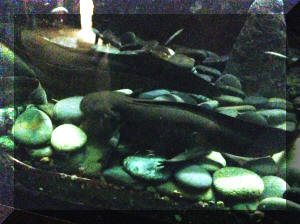 |
|
We ask that, before
submitting a query, you refer to Neale Monk's:
Before You Write; A Checklist of Common
Problems with Freshwater Aquaria,
Bettas, Goldfish, and Freshwater Turtles
(Terrapins), Tips on Asking
Questions,
Ask the WWM Crew a
Question, FAQs on FAQs.
EDFP,
TBPFWFAQs, Last Few Days Accrued
FAQs,  Subscribe to the
Daily Pics Subscribe to the
Daily Pics
|
|
Updated FAQs On
Planted Aquariums & Livestock
Updated
3/2/20
Aquarium Garden SubWeb Index
Other Specialized Daily FAQs Blogs:
General,
Ponds,
Brackish,
Last Few Days Accrued FAQs,
Daily Q&A replies/input from the WWM crew: Rick Novy, Sue
Garrett, Darrel Barton, Neale Monks, Marco Lichtenberger,
Sabrina Sharp, Eric Russell, Chris Perivolidis,
Chuck Rambo, Bob Fenner, are posted here. Moved
about, re-organized daily
Current Crew Bios.,
Not so current
Crew Bios
____________________________________________________________
|
 |
New
Print
and
eBook on Amazon
Betta Success
Doing what it takes to keep Bettas healthy long-term
by Robert (Bob) Fenner
|
Substrate for New 90 gallon setup for clown loaches and
plants; 40 gallon sump, no CO2, 6x water change/hr.
2/29/20
Hi,
I'm trying to decide on substrate. I was thinking of doing a sand
capped soil but am getting cold feet on starting a "new" method to
me on such a large tank and the start up process with ammonia, etc.
<Understood. If you want to use soil (ideally, aquarium soil, but
pond soil can work too) the key problem is ensuring there's enough
time for plants to bind everything together before the fish dig up
the soil. The soil will tend to rise, and the sand tend to sink, but
this will take some weeks.>
Sand seems important for loaches but maybe not best for plants. How
do I know if I have soft/smooth sand?
<Sand is branded as either 'smooth' or 'sharp', so usually checking
for these words will help. By default, sharp sand is what you see in
garden centres, being favoured for adding drainage to soil mixtures.
Sharp sand is also widely used in building. Smooth sand is often a
special thing, advertised as such. You'll see it in garden centres
as well, where it's got specific uses in horticulture. It's also the
sand usually used in play-pits and pool filters, but check. Smooth
sand will feel silky, while sharp sand feels gritty.>
What do I look for? Is pool filter sand smooth?
<See above.>
If capping with sand, think I need a gravel tidy to keep sand from
falling between larger grain size of the capped material. Yes?
<Quite possibly. but depends a bit on how fast the plants get
rooted: once they've spread out their roots, the sand and soil won't
really mix much.>
What are some good brands of gravel tidy/soil retainer? What
characteristics for root penetration?
<Gravel tidies are entirely generic with no real advantages. Indeed,
even plain plastic pond mesh will work.>
If I am worried about soil/sand mixture below tidy, what are other
good options? Just a gravel? What grain size?
<A mixture of soil (or a mineral rich additive, such as laterite)
with fine gravel, then topped off with another 2-3 cm of gravel, and
work extremely well. It's easier to do, perhaps, but less good for
those fish like loaches that want to borrow. On the other hand,
gravel is often darker, so less reflective of light, which can
improve the colours of your fish. Horses for courses, really.>
Should I be worried about soil?
<Not really. Use it sparingly unless you're planning to have rampant
plant growth. Much easier to add extra nutrients via plant
fertiliser tablets than to remove surplus soil because of an algal
bloom. While some (usually ecologically only temporarily submerged)
plants are root-hungry and appreciate soil substrates, such as
Amazon Swords, true submerse plants, such as Vallisneria, can get
most if not all of their nutrients via the water, so soil isn't
going to make much difference for them. Again, pick your poison
according to your aim.>
It just seems that there are too many variables to know what you are
buying in potting soil.
Thanks!
<Most welcome. Cheers, Neale.>
Re: Substrate for New 90 gallon setup for clown loaches and plants;
40 gallon sump, no CO2, 6x water change/hr.
3/2/20
Hi,
<Hello.>
Some follow ups below. Thanks!
What density mesh is needed?
<Commercial gravel tidy has gaps a few mm across. Doesn't really
matter so long as its fine enough to reasonably separate the two
layers and stop fish even starting to burrowing through so they
don't accidentally get stuck, but coarse enough the roots can
penetrate.>
What ratio of fine gravel to laterite?
<Will vary, but something like 25% laterite supplement to 75% fine
gravel is about right. A bit less won't do any real harm though will
need topping up with nutrient tablets more quickly, while too much
is expensive and may
cause an algal bloom if plant growth is inadequate.>
Where would I purchase laterite?
<Various commercial brands; the one I've used is Duplarit.>
Is this an expensive route?
<Fairly, if you use the premium stuff. There are workarounds using
home-brew recipes (see online) or pond soil (messy, but does work).>
Will this mix have the same issues with ammonia and algal blooms?
<See above; yes, if you have more nutrients available than your
plants are using up. But this is the same, regardless of the
nutrient media used in the substrate, or indeed if the water becomes
eutrophic.>
What thickness fine gravel/laterite mix?
<No more than the bottom-third is really needed, if that.>
Couldn't I still cap with sand? If so, what thickness?
<Yes; normally you'd have a couple cm the laterite mix, then 5+ cm
of plain gravel or sand, as the situation demands.>
For sand , what grain size range do you consider "fine"
<Standard aquarium sand is adequate, otherwise normal 'smooth'
silica sand (or silver sand) as used in horticulture. Cheers,
Neale.>
|
Worms that came with Dwarf Horsetail
8/26/19
Hello WetWebMedia,
I ordered some Dwarf Hairgrass Bunches (Eleocharis parvula) from Florida for my
fish tank, but there are worms in the bags. Do you know what kind of worms they
are and if they pose any threat to myself or my fish?
Thank you!
<Mmm; appear to be some sort of Oligochaete (like earthworms); not likely
problematical for you or your aquatic livestock. Bob Fenner>
|
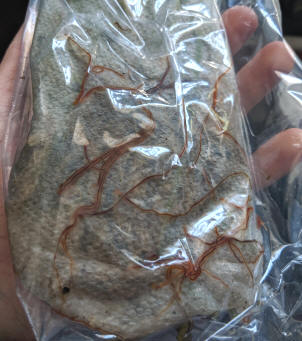 |
|
Killer ferts? 2/8/19
Good evening WWM crew,
<Linda>
I think I may have injured my Bolivian ram with dry fertilizer.
<Mmm; for all (you and browsers into perpetuity), a good idea generally (unless
using specially diluted, slow-release FOR AQUARIUM products) to dilute such in
water, use sparingly; with test gear>
I do EI fertilizer dosing in my display tanks with dry fertilizer. I generally
dose K2SO4, KH2PO4, and CSM+B, and let the fish take care of providing the NO3.
<Okay>
Shortly after I dosed my 120 gallon a few days ago (following the usual
50% water change), I happened to walk by the tank and notice that my
male Bolivian ram was not with his mate (quite unusual; they were a breeding
pair and generally don’t wander far from one another). After a few moments, I
spotted him lying on his side, still breathing (a bit rapidly, but not gasping)
and still moving his pectoral fins. He’s full grown; I’ve had them both for
about four years, and I thought perhaps he got in the way of the ferts and got
stunned, so I left him there to see if he’d recover.
<Mmm; well; a note re such large water changes. Given that so many places have
varying water quality, concentrations of sanitizer (chloramine mostly in the
west), I encourage folks to limit percentages to 20-25% at any one time... AND
if at all practical, to store, heat (add supplements) to new change out water...
Perhaps keeping it a week ahead of use. In other words, I'm inferring that
perhaps some influence here may be due to the new water, not simply the
fertilizer>
Parameters in the tank were 0 ammonia/nitrite and between 10-20 ppm nitrate.
Temp was between 74-76F (room temperature in my house), pH 7.2, gH and kH in the
50-100ppm range (I use remineralized RO/DI water so my parameters are very
consistent in that regard).
<Good>
A few hours later I checked on him; he’d moved a bit, swimming backward and
still on his side, and wedged himself between two stems of Rotala. He was still
breathing and moving his pectoral fins, his color was good, and he didn’t appear
bloated or have any visible signs of disease or injury other than his lack of
buoyancy control. His mate seemed to be watching over him anxiously. I left him
there, and hoped for the best.
The next day he was in the same spot, and I assumed he had passed ... but when I
went in to remove him, he swam away — still upside-down. His condition was no
better or worse than the day before.
However, at this point I decided to put him in quarantine to see what I could
do. He’s now in a bare bottom tank with the same parameters (little to no
nitrate) at 80F and 2g/L NaCl; so far, no change, but he does seem to be
swimming a bit more. If I set him upright, he does the ‘belly scoot’ for a
moment and then falls over again.
<Mmm; I'd've left this fish in place; would move it back now.>
Before I start throwing meds at him, I figured I’d check with the experts so I
don’t accidentally make him worse. I haven’t tried feeding him, but I doubt very
much that he’ll eat in his current condition, and I know the first-line
treatment for swim bladder issues usually includes fasting the fish.
<I would NOT add medicine, nor do anything extraordinary in the way of offering
foods>
Photo included in case you see symptoms I missed. Sorry about the lighting; my
QT and hospital tanks are inside my stand.
Thanks for reading,
Linda A
<Thank you for sharing. Again, I would move this Cichlid back to the
main/display; pre-mix fert.s, pre-make and store change-out water. Bob Fenner>
|
.jpeg) |
|
Impulse buy plants.....Ooops
12/16/18
Hi Bob,
<Jill>
Neale says your the plant expert. Can you answer some questions about some
plants?
<I'll try>
I went to 45 minutes far away plant store to buy some Watersprite. They had so
many pretty plants.. i was trying to stick to ones I researched but I let the
advice of their plant guy be enough. He said the red tiger lotus does well in
his low to medium light tank.
<Mmm; okay. Nymphaea (likely zenkeri)... can/does>
I bought several plants I didn't know anything about due to its such a long
drive, I know I should have researched more...but the guy said they would work.
I had also bought some at a nearby pet store so now the tank is pretty full.
<Okay>
I was having some algae issues so I am trying to clean it a little more
frequently (25% partial water changes), sprinkle the food lighter, and to add a
lot of plant life planted into some fluorite that I buried under some of the
gravel to hopefully outcompete the algae. Will the red tiger be useful in this
purpose, or harmful to growth of my other plants?
<Likely to be fine; though I'd keep it cropped, contained... Not let the leaves
reach the surface>
I have some crypts, Anubias, that grassy patch at the front, Bacopa and
something that looks similar to Bacopa, and Anubias and java moss, and water
sprite. I had the Anubias the longest but it grows so slow, it gets algae.
<Mmm; I'd look into useful algae eaters here. Some Otocinclus perhaps... even
shrimps if they'll fit w/ your present livestock plan>
And also, please identify the stringy long stemmed green one floating behind the
red tiger lotus? That one has roots and not a bulb. I also added a photo of it
from above.
<Mmm; don't see this and there's only the one pic>
And also, what's this one that's floating at the top? I don't think its Bacopa.
<The plant on the left appears to be>
Also, can you identify this little grassy parch thing? It was sold as tissue
culture and no name.
<Again; don't see what you're referring to>
I have a strip of LEDs, and then I bought a plant lamp from IKEA. I think
they're each about 20-25 watts. I hope the plants will do ok! I did research on
low light plants but the one floating at the top, the red tiger lotus, and the
tall green floaty thing behind it were my impulse buys.
Store employees keep tanks and told me of their own luck with them.
<Should be fine. A plug for Karen Randall's "Sunken Garden's" book, for brief
input re soil, nutrient, CO2... and most common plants, fishes,
invertebrates of use. Bob Fenner>
|
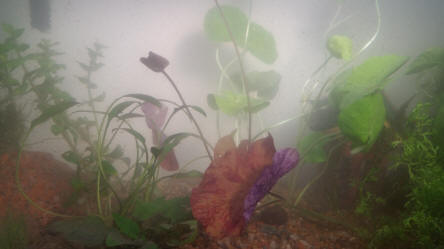 |
|
Re: Impulse buy plants.....Ooops
12/16/18
Sorry, I forgot to attach the other photos for you to id. Here you go.
<201415 appears to be a Hydrocotyle; the other two pix, likely Bacopa and
an Eleocharis. BobF>
|
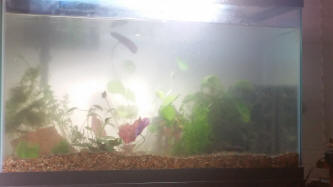 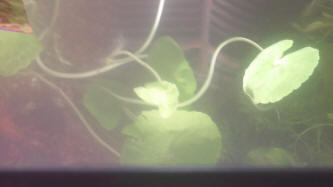
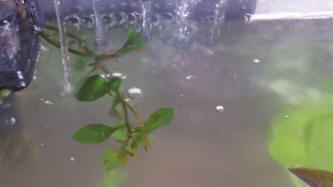 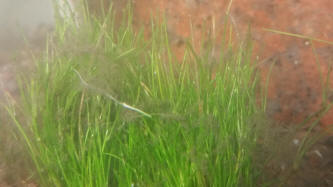 |
|
Re: Impulse buy plants.....Ooops 12/17/18
Well, I've clearly made a huge error in judgment impulse buying that beautiful
red tiger lotus. There seems to be a general consensus that it will quickly
overtake a tank and the roots go under all the other plants roots making it
difficult to extricate.
<Mmm; well; keeping the floating, almost floating plants will fore/stall this
for quite a while; AND there is the technique of "blind potting" such plants...
cutting down a plastic bottle, using an inert tray with gravel, soil if you
like... to contain such root growth>
I have another tank that I'm going to move it to, and I'll cut the tall leaves
so that it doesn't flower and seed. It can be a specimen tank for tiger lotus,
though it sounds like it's more of a pond plant...I should
have read before buying.
https://pethelpful.com/fish-aquariums/red-tiger-lotus-in-an-aquarium [https://usercontent1.hubstatic.com/8162950_f1024.jpg]
<Ahh!>
How to Plant a Tiger Lotus (Nymphaea Zenkeri) in an Aquarium<https://pethelpful.com/fish-aquariums/red-tiger-lotus-in-an-aquarium>
Some people prefer to grow these beautiful plants in ponds instead of aquariums
because of their growth rate. But the difficulties of planting a red tiger lotus
in an aquarium are easy to overcome.
If anyone can identify the other plants in the photos, the green tall one, the
grassy one, and the floating one, I would appreciate it. ;-)
Thanks,
Jill
<Do see our previous email. I gave you my ID input there. Cheers, Bob Fenner>
Re: Impulse buy plants.....Ooops 12/18/18
Thank you Bob!!! That's awesome. I'll try that. I love this beautiful plant and
this 30 gallon really is the best tank I have to fit this size of a plant.
<Okay!>
Your i.d.'s are missing from this thread below. Will you please try again
sending the email where you i.d.'d them?
<See here:
http://wetwebmedia.com/PltSysDailies.htm>
Thanks.
Re: Impulse buy plants.....Ooops 12/18/18
Thanks.
I have wild harvested South American Lime Green Endler's.
It appears that Otos are strictly vegetarian? Would be unlikely to go after
Endler's fry? I wonder if Endler's would go after Oto fry....
http://www.otocinclus.com/feeding.html
<They are almost exclusively algae eaters; I don't think they'd consume
livebearer fry>
The Endler's do not eat their young. I have very much been wanting to add Cherry
Shrimp to the tank, but worried that they might possibly chase the different
species fry.
<RCS won't eat Endler's young either, the opposite though...>
I am trying to build up the plant life though and I guess I could also remove a
female shrimp when she is carrying eggs and put her in a smaller tank until they
grow...
<Mmm; lo dudo. I doubt this>
Can you recommend a good grassy plant to spread and carpet the front, and or is
that one I have decent?
<There are a bunch of choices here. Bucephalandra is a current fave of many, and
readily available. Are you familiar with the AGA group/site?
https://www.aquatic-gardeners.org/
You'd very likely enjoy perusing, interacting w/ folks there as well>
Thank you again Bob.
<Welcome Jill. B>
Re: Impulse buy plants.....Ooops 12/19/18
Thank you Bob, I'll check out that garden site.
<Welcome Jill. Am sure you'll enjoy, gain by the experience. BobF>
|
Anubias Melt 10/6/18
Hi Guys,
<Hello Ted,>
I have followed you for a long time. I wanted to ask about Anubias melt. It
seems that searching on the internet there are very few hard leads to the cause.
I have noticed it mostly in plants that were grown emersed in fiber glass.
<Which may be a clue. Not all Anubias species grow well, if at all, underwater.
They are, after all, amphibious plants rather than true aquatics, often with
their roots attached to wood or rocks that are
underwater some of the time, but the stems and leaves well above the waterline.
Your standard issue Anubias barteri and its various varieties should adapt well
though, and have been among the best aquarium plants for years, but other
species seem a bit hit-and-miss. I'd also make the point that similar looking,
but definitely not aquatic, plant species might be substituted by some retailers
and eBay sellers. When I was a kid, it was fairly common for houseplants such as
Spathiphyllum 'peace lilies' to be
offered as aquatics, and while some might last a few weeks or months, inevitably
the leaves would soften and rot, and then the plant would die.>
There are few major outward signs which plants that suddenly turn to mush.
A few very green leaves might drop but little else. The plants are shaded by a
large piece of drift wood and placed between rocks.
<Good; Anubias seem to dislike directly overhead lighting.>
The melt occurs in the first 2 weeks of being in the tank.
<This does sound like typical plant 'shock' rather than some specific disease.
If possible, remove the dead leaves carefully, but leave the stolon in place. Do
ensure the stolon is absolutely clear of the substrate or any sort of fibre
glass wool. It should be placed on a rock or bogwood root somewhere that it is
able to get some light so it can photosynthesise (that's why it's green) and
after a few weeks you should see some new leaves. I find Anubias recover from
damage rather well, all else being equal. Do review water chemistry, though
Anubias barteri at least will adapt to a very broad range, from blackwater
conditions through to slightly brackish. Other species might be more picky.
Finally, do try removing one of the plants (or a cutting from a stolon) to
another tank if possible.
Why? Because if you have some sort of allelopathy between plant species, you
might find that the separated plant thrives, while the ones left in the tank do
not.>
No other additions melt or lose leaves including my crypts.
<Anubias do enjoy similar conditions, and I've not observed allelopathy between
Cryptocoryne and Anubias. Usually, they thrive when grown together.
Of course, that assumes the Cryptocoryne are placed in the substrate while the
Anubias are not.>
Where else would you have me look to discover an answer?
<There are a number of good aquatic plant forums out there, such as ukaps.org,
and these might be able to offer some extra help.>
Thanks
Ted
<Hope this helps. Neale.>
|
Few questions; Java Moss use
8/7/18
Gday Neale
Hope you’re well mate
<Can't complain, me old cobber.>
Just got a few questions for you hopefully you might help me out.
<Sure thing.>
I’ve started to build a wall in my tank with plastic mesh and java moss it grows
crazy in my tank....
<Yes. Often does, once it takes. Odd stuff, Java Moss. Sometimes thrives;
sometimes miserably hangs in there.>
My concern is that behind the walls will it become “dead spots”. The fish do go
behind which I’m hopefully going to stop soon and give the shrimps that are in
there a place to live “behind the scenes” once all the walls are complete.
<Understood. There is some argument for giving the moss a hair cut periodically
if the dead spots are substantial. This is akin to the theory of algae
scrubbers, where a 'turf' of green algae on mesh panels helps to filter the
water, but if the turf becomes too thick, the efficiency of this diminishes as
water movement reduces. But that said, tiny shrimp babies and fish fry thrive
inside dense thickets of moss.>
Do you think this will be an issue with dead spots?
<It can be if you find the moss deep inside the thickets turning brown and/or
trapping a lot of silt. Not dangerous bad, but unsightly, and not doing anything
useful. But if the moss is green all the way through, it's probably fine, and
doesn't need any particular help from you.>
please see photos below
<The tank looks awesome, to be honest, and there's nothing wrong with
encouraging the moss to cover as much of the back pane as you'd like. Everything
looks perfectly healthy to me. Cheers, Neale.>
|
.jpeg) .jpeg) |
Aquatic plant weights caused cloudy water
3/25/18
Hi, My name is Larry.
I purchased some aquatic plant weights for our 20 gallon freshwater fish
tank.
Our tank is about 2 months old and we have 5 guppies, 2 catfish, 2 frogs
and 2 snails. We also have 1 piece of driftwood and a few live plants.
<Mmm; the driftwood is far more likely at play here... re the
cloudiness>
I received these plant anchors from Awesome Aquatics and I think because
I forgot to rinse/soak the anchor/weights prior to putting them into our
tank last night and woke up this morning with a cloudy tank?
<Am wondering concerning this. When I was much younger I worked for a
local wholesaler, Pratt's (Tropicals); and Charlie is still alive,
active in the local tropical fish society (SDTFS); and one job we had
was cutting up lead sheet (yes, the metal) into strips for plant
weights. Also, all the commercial weights for this purpose I've ever
occasioned were also lead... shouldn't leach metal into the water unless
the pH is VERY low>
Should I wait and let the filter run its course or should I do a 25%
Water change?
<I'd do the change, add some activated carbon (nee charcoal) to your
filter/flow path>
I hope to hear back from you soon.
Thanks so much and have a great day,
Larry
<This could also/otherwise be a coincidental "bacterial bloom"... a
profusion of microorganisms so dense that they obscure light
penetration.
The latter could be checked with a microscope, sample. For me, I'd
remove the driftwood for now; see if this doesn't result in substantial
clearing in a week or so. Bob Fenner>
Re: Aquatic plant weights caused cloudy water
Bob,
<Larry>
Thanks for the reply!
<Welcome>
FYI - I had the driftwood and plants in our tank 1 week prior having any
fish. Like I said in the prior email, all was good until I put the lead
strip weights on last night?
<Meh; am a very old timer in these fields... not the weights almost
assuredly; but look up driftwood on WWM; very common that it decomposes
in time, causes cloudiness and alters water chemistry>
I did the water change and it cleared up a little bit still cloudy! I
did check the water and PH is low so I added PH up (API).
<Had it dropped appreciably? Again, the wood. To repeat; I'd remove it
and see>
Thanks again for you advise and hope to hear from you again .
Larry
<Again, certainly welcome. Bob Fenner>
Handling Moneywort 2/14/18
Hi Guys,
<Shriram,>
I just got into to getting used to a planted aquarium. My tank is a bare
bottom one with Angles and a discuss.
I added some black soil to one corner of the tank and got moneywort
plant which was rooted in a small plastic cup.
<Is this Bacopa monnieri? An interesting plant, but quite demanding.
Needs very bright light!>
My LFS asked me to place the soil in a bowl and place the plastic cup
along with the plant in the soil and place the bowl in the tank.
<Can be done this way. Essentially like growing a houseplant in your
aquarium.>
But instead I have placed the soil directly in one corner of the tank
and placed the plastic cup half submerged in the soil.
<Or this. Is the "plastic cup" one of those with lots of holes in the
side, so the roots can grow out? These often have the plant roots
covered in a sort of mineral wool that looks like loft insulation! Yes,
you can leave the plants in these pots, and after a while the roots will
spread outwards into the gravel or sand.>
I have my tank light running usually a few hours in the morning and a
few hours in the evening. I can see that the plant looks pale before the
light is switched on and once after the light is switched on, it seems
to look a little better. But I still feel that the plant may not be in
its best health. I can also see some leaves floating around the tank
once a while. I do not have a CO2 system for the tank.
<Bacopa monnieri is not difficult to grow, but it does need very bright
light. It's normally grown by removing the stems from the pot, placing
them loosely into the substrate, and letting nature take its course.
Bacopa monnieri is actually a marsh plant, but will do okay in fish
tanks given enough light.>
Please guide me in what can be done for the better health of the plant.
Thanks and regards,
Shriram
<Hope this helps, Neale.>
Re: Handling Moneywort 2/14/18
Hey Neale,
<Shriram,>
Yes you are right its kind of a small "plastic cup" with holes in the
sides.
<Cool. These do work well. Many people remove them of course.>
I am now looking at increasing the period the aquarium light needs to be
switched on to around 8 hours.
<Oh, definitely, BUT do remember: long light period is not a substitute
for brighter light! Plants each need to certain intensity of light to
grow.
It's a certain 'threshold' that needs to be exceeded. Moneywort is
fairly demanding, as its light green colour would suggest. Darker leaf
plants, like many Cryptocoryne, will handle less light.>
I have the heater temperature set to 26 C that is around 78 F. Do I need
to make any changes to that. I currently house Angels and a Discus.
<26 C is a bit low for Discus, but ideal for Angels. Most people avoid
mixing the two species. Angels will bully Discus, and carry some
parasites that cause Discus major problems. Be careful!>
Mine is a 10 gallon.
<Not really big enough, long term, for Angels or Discus.>
Regards,
Shriram
<And to you too, regards! Cheers, Neale.>
Re: Handling Moneywort 2/14/18
My Angels and Discus seem to be nipping the moneywort. Is this common.
<No. They may simply be hungry.>
Thanks and regards,
Shriram
<Cheers, Neale.>
Plant Question 10/31/17
Hello Crew! Hope all is well with you and that you can clarify a point
of aquarium plant care for me. I recently added water lettuce
to my 125 gallon tank that houses 7 fairly large (9 - 11
inches)
weather loaches to help keep the nitrates under 20 ppm.
<For all (and me), this is Pistia stratiotes, right?>
They're beautiful plants and I did my research, so I think my situation
will suit them very well as far as lighting, temperature, and water
parameters. Also, the loaches love playing with them.
<Yes; both are cool, really pond organisms; that enjoy moderately hard,
alkaline water>
They push them around the tank in what appears to be a game of "fishy
soccer." One fish pushes the plant around until another fish sneaks up
and steals it away to push it in another direction. It's actually fun to
watch!
But a friend of mine who saw them playing their game told me I should
not let them do that (Seriously?) because as they push the plants around
the surface of the water, and sometimes pull them under for a brief
moment, will flood the plant. He told me the top of the plant cannot get
wet or it will rot. Is that true?
<I don't think so. Have used this plant by the thousands (in ponds and
lakes principally) in conditions where they were rained on, irrigated
often; no worries>
If it is true, I'll have to remove the plants, but they seem to have
very waxy leaves and I don't see the water penetrating through that -
but you have the final say!
*Renee *
<I'd leave all as is. Bob Fenner>
Re: Plant Question 11/1/17
Great! I didn't want to take away what has become the loaches 2nd
favorite toy (they love "surfing" in their powerhead current the best.)
I don't know if they are Pistia stratiotes, but they look like the
pictures of that species in the photos I've found online.
<Mmm; the curse of common names... Pistia doesn't generally do well in
aquariums; due to lighting issues mainly... either burned or not getting
enough, due to arrangement and proximity to lamps>
I was down at a local pond store and they had this tub of what they
called water lettuce outside in their nursery area. Evidently the
remaining plants did not sell over the summer, so the store was going to
leave them to freeze to death over the winter (stupid, stupid, stupid).
Most of them were already dead and rotting (our overnight temperature
has been down in the upper 20's for the last couple of weeks) but I was
able to salvage 14 plants and I've put two in each tank (4 in the loach
tank) because I understand that they will reproduce quickly once fully
recovered. I don't understand why they're not more popular in aquariums
as they are a beautiful, low maintenance (no Co2 required) plant, and
fish love them!.
Thank you for the great news!
<Welcome! BobF>
Re: Plant Question 11/1/17
Great information - my aquariums don't have the standard aquarium lights
on them. Mine have your regular fluorescent lights (a solely economic
choice) with plant bulbs in them. They hang about 4 - 6 inches off the
top of the tanks.
<Ah good>
The lids on my tanks are not standard glass lids either (all of my tanks
have "obligate air breathers" in them loaches, rope fish, Senegal
bichirs), so my lids are egg crate covers (normally for fluorescent
lights) cut to fit the tank with 1/4 inch squares, so there is a certain
amount of light diffuse and air circulation, but I can still maintain
51% humidity in the tank.
<Very good indeed>
Also, I keep the water levels about an inch from the surface. All of the
tanks have canister filters with spray bars and either powerheads or air
stone bubblers to keep current moving in otherwise stagnant areas. But
I'll make whatever adjustments I need to make to ensure the plant's
health and growth. Do you see anything
above that you think I should change/adjust?
<I do not Renee. There is some seasonal die-back with this (and many
other
surface plants) species. You'll see this as yellowing, darkening of
outer
leaf areas, slow down in growth. Bob Fenner>
Re: Plant Question
Great! Thank you again! Have a great day!
<And you Renee. B>
|
|

